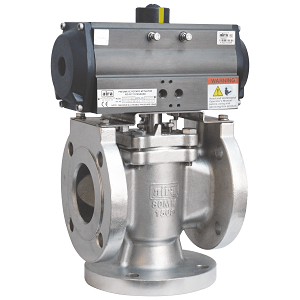Different Types of Plug Valve

This is an informational article for our readers who have thrust to get details about industrial valves. In this article, you found all types of plug valves. The plug valve is one of the quarter-turn rotating motion valves like the Ball valve. The plug valve has various types available based on its design and working principles. There are four types of Plug valves available in the valve industry. Each of them has its specific properties and uses. We will take a brief look at all of them, from their working principle to their uses.
Lubricated Plug Valve
As the name defines, this type of plug valve requires Lubrication. The lubrication is injected in with pressure between the face of the plug and the body seat so that the valve can perform with minimal friction and seal ports. This lubricant is usually made up of a base oil and viscosity improver. Valve manufacturers generally advise suitable process fluid as a lubricant and the valves must be re-sealed with these lubricants after a few cycles and in some cases after every cycle. As we are aware that these valves require constant lubrication, they are often used in processes that have unusual operations.
Lubricated Plug Valve performs its best in processes that utilize mildly rough particles, like Dirty Upstream applications, Gas pipeline systems that need bypass valves, a blow-down valve on valve stations, and kicker valves.
Also Read: How are Plug Valves Different from Ball Valves
Non-Lubricated Plug Valve
The plug, in Non-Lubricated Plug valves, is tapered or cone-shaped, which acts as a wedge and presses the polymeric sleeve against the body cavity. This polymeric sleeve reduces the friction between the plug and the body. This sleeve is made from a non-metallic polymer material as a result allowing smooth movement of the plug and it binds the limit such as high-temperature tolerance.
These plug valves are generally used in applications needing low-maintenance, such as special services in hydrogen fluoride, sulfur, or liquids that can solidify and potentially jam the valve. These non-lubricated Plug Valves are ideal for low maintenance applications in comparison to the lubricated Plug Valves.
Below are a few, most common types of Non-Lubricated Plug Valves available in the valve industry:
(i) Lift-type Plug Valve (ii) Elastomer sleeved Plug Valve and (iii) Fully Lined Plug Valve
Eccentric Plug Valve
In the Eccentric Plug Valve, the Half Plug used applies minimum friction to the seat with a higher seating force. The torque seated Eccentric Plug valves also improve tight shut off capabilities. These valves are used to control flow and in isolation applications such as sewage, sludge and slurries, clean and dirty water, air, etc.
Expanding Plug Valve
These type of Plug valves are generally used for applications which require positive shutoff, verifiable zero leakage and double block-and-bleed capabilities. Its complex design is based on multiple components that allow the valve to expand mechanically and provide double block-and-bleed capabilities. This valve protects both the seals from the flow path either in an open or in a close position. These types of valves often are used to prevent product contamination in applications that do not require double isolation.
Conclusion
In conclusion, the Plug valve has many varieties available and our engineers have designed and modified them as per your need and working requirements. With the help of modern technology, many manufacturers have designed various plug valves with numerous sizes and properties.
We have designed the Pneumatic actuator operated plug valve and also make manual operated plug valves.


